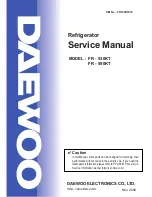
5.
HELPFUL HINTS AND TIPS
5.1
Normal Operating Sounds
• You may hear a faint gurgling and a
bubbling sound when the refrigerant
is pumped through the coils or tubing.
This is correct.
• When the compressor is on, the refrig-
erant is being pumped around and
you will hear a whirring sound and a
pulsating noise from the compressor.
This is correct.
• The thermic dilatation might cause a
sudden cracking noise. It is natural,
not dangerous physical phenomenon.
This is correct.
5.2
Hints for energy saving
• Do not open the door frequently or
leave it open longer than absolutely
necessary.
• If the ambient temperature is high and
the Temperature Regulator is set to
low temperature and the appliance is
fully loaded, the compressor may run
continuously, causing frost or ice on
the evaporator. If this happens, set the
Temperature Regulator toward warm-
er settings to allow automatic defrost-
ing and so a saving in electricity con-
sumption.
5.3
Hints for fresh food
refrigeration
To obtain the best performance:
• do not store warm food or evaporat-
ing liquids in the refrigerator
• do cover or wrap the food, particularly
if it has a strong flavour
• position food so that air can circulate
freely around it
5.4
Hints for refrigeration
Useful hints:
Meat (all types) : wrap in polythene bags
and place on the glass shelf above the
vegetable drawer.
For safety, store in this way only one or
two days at the most.
Cooked foods, cold dishes, etc.: these
should be covered and may be placed
on any shelf.
Fruits and vegetables: these should be
thoroughly cleaned and placed in the
special drawer(s) provided. When in con-
tact, lemon juice can discolor the plastic
parts of your fridge. It is therefore rec-
ommended to keep citruses in separate
containers.
Butter and cheese: these should be
placed in special airtight containers or
wrapped in aluminium foil or polythene
bags to exclude as much air as possible.
Bottles: these should have a cap and
should be stored in the bottle rack on
the door.
Bananas, potatoes, onions and garlic, if
not packed, must not be kept in the re-
frigerator.
5.5
Hints for freezing
To help you make the most of the freez-
ing process, here are some important
hints:
• the maximum quantity of food which
can be frozen in 24 hrs. is shown on
the rating plate;
• the freezing process takes 24 hours.
No further food to be frozen should
be added during this period;
• only freeze top quality, fresh and thor-
oughly cleaned, foodstuffs;
• prepare food in small portions to ena-
ble it to be rapidly and completely fro-
zen and to make it possible subse-
quently to thaw only the quantity re-
quired;
• wrap up the food in aluminium foil or
polythene and make sure that the
packages are airtight;
• do not allow fresh, unfrozen food to
touch food which is already frozen,
thus avoiding a rise in temperature of
the latter;
• lean foods store better and longer
than fatty ones; salt reduces the stor-
age life of food;
• water ices, if consumed immediately
after removal from the freezer com-
partment, can possibly cause the skin
to be freeze burnt;
ENGLISH
31
















































